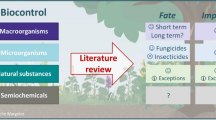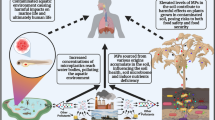Abstract
The feasibility of poplar (P. tomentosa) foliages as passive biomonitors for organochlorine pesticides in air was explored. The accumulation patterns of poplar foliages for HCHs, DDTs and HCB were similar, the amount of HCHs, DDTs and HCB increased with foliage growth in spring, and decreased thereafter. There was no obvious distinction in the accumulation styles between the adult leaf and the leaf-litter. This accumulation pattern is likely related to the growing process of the poplar foliage, and was observed for the first time in our work, giving an evidence for the “bud burst effect” in plants. The technical HCH and DDT were used largely in history and not used in recent years, but there was a little usage of lindane and new input of o,p’-DDT in recent years, and dicofol usage may be the main source of o,p’-DDT. Concentrations of HCHs, DDTs and HCB in poplar foliages were similar to those in pine needles at the corresponding period, and there is a positive strong correlation between OCP concentration data of two kinds of trees. It presents no difference in the accumulation style between two kinds of trees. The level of OCPs in the poplar foliage reflected the pollution status of OCPs in air. The result of this work showed that the poplar foliage can be used as the bio-monitor of OCPs in air.
Similar content being viewed by others

References
Hua X M, San Z J. The production and application of pesticides and factor analysis of their pollution in environment in China (in Chinese). Adv Environ Sci, 1996, 4: 33–45
Li V F, Cai D J, Singh A. Technical HCH use trends in China and their impact on the environment. Arch Environ Contam Toxicol, 1998, 35: 688–697
Zhou J L, Maskaoui K, Qiu Y W, et al. Polychlorinated biphenyl congeners and organo-chlorine insecticides in the water column and sediments of Daya Bay, China. Environ Pollut, 2001, 113, 373–384
Xu D D, Zhong W K, Deng L L, et al. Regional distribution of organo-chlorinated pesticides in pine needles and its indication for socioeconomic development. Chemosphere, 2004, 54: 743–752
Cheng J P, Wu Q, Xie H Y, et al. The accumulation of polychlorinated biphenyls in camphor tree leaves in industrial area of Shanghai (in Chinese). J Shanghai Jiaotong Uni, 2007, 41(7): 1185–1188
Cheng J P, Zhao W C, Xie H Y, et al. Correlation of PAHs in PM10—phoenix tree leaves—soil system of a coking and chemical factory in Shanghai (in Chinese). Environ Sci, 2007, 28: 1802–1805
Eriksson G, Jensen S, Kylin H, et al. The pine needle as a monitor of atmospheric pollution. Nature, 1989, 341(6237): 42–44
Jensen S, Eriksson G, Kylin H, et al. Atmospheric pollution by persistent organic compounds: monitoring with pine needles. Chemosphere, 1992, 24: 229–245
Calamari D, Tremolada P, Guardo A D, et al. Chlorinated hydrocarbons in pine needles in Europe: fingerprint for the past and recent use. Environ Sci Technol, 1994, 28: 429–434
Kylin H, Grimvall E, Ostman C. Environmental monitoring of PCBs using pine needles as passive samplers. Environ Sci Technol, 1994, 28: 1320–1324
Juuti S, Norokorpi Y, Ruuskansen J. Trichloro-acetic acid (TCA) in pine needles caused by atmospheric emissions of kraft pulp mills. Chemosphere, 1995, 30: 439–448
Gaggi C, Bacci E, Calamari D, et al. Chlorinated hydrocarbons in plant foliage: an indication of the tropospheric contamination level. Chemosphere, 1985, 14: 1673–1686
Yang P, Chen J W, Wang Z, et al. Contributions of deposited particles to pine needle polycyclic aromatic hydrocarbons. J Environ Monit, 2007, 9: 1248–1253
Lamppu J, Satu Huttunen. Relations between scots pine needle element concentrations and decreased needle longevity along pollution gradients. Environ pollut, 2003, 122: 119–126
Wang D G, Chen J W, Xu Z, et al. Disappearance of polycyclic aromatic hydrocarbons sorbed on surfaces of pine (pinua thunbergii) needles under irradiation of sunlight: volatilization and photolysis. Atmos Environ, 2005, 39: 4583–4591
Chen J W, Zhao H M, Gao L N, et al. Atmospherric PCDD/F and PCB levels implicated by pine (cedrus deodara) needles at Dalian, China. Environ Pollut, 2006, 144: 510–515
Sutinen S, Lumme H, Maenpaa M, et al. Light microscopic structure of needles of scots pine (pinus sylvestris L.) in relation to air pollution and needle element concentrations in S.E. Filand and the Karelian Isthmus, N. W. Russia. Trees, 1998, 12: 281–288
Niu J F, Chen J W, Henkelmann B, et al. Photodegradation of PCDD/Fs adsorbed on spruce (picea abies L. karst) needles under sunlight irradiation. Chemosphere, 2003, 50: 1217–1225
Xu D D, Zhong W K, Deng L L, et al. Levels of extractable organo-halogens in pine needles in China. Environ Sci Technol, 2003, 37: 1–6
Wu W Z, Schramm K W, Henkelmann B, et al. PCDD/Fs, PCBs, HCHs and HCB in sediments and soils of Ya-Er lake area in China: results on redidual levels and correlation to the organic carbon and particle size. Chemosphere, 1997, 34(1): 191–202
Hung H, Thomas G O, Jones K C, et al. Grass-air exchange of polychlorinated biphenyls. Environ Sci Technol, 2001, 35: 4066–4073
Thomas G O, Smith K E C, Sweetman A J, et al. Further studies of the air-pasture transfer of PCBs. Environ Pollut, 1998, 102: 119–128
Smith K E C, Thomas G O, Jones K C. Seasonal and species differences in the air-pasture transfer of PAHs. Environ Sci Technol, 2001, 35: 2156–2165
Simonich S L, Hites R A. Vegetation-atmosphere partitioning of PAHs. Environ Sci Technol, 1994, 28: 939–943
Simonich S L, Hites R A. Organic pollutant accumulation in vegetation. Environ Sci Technol, 1995, 29: 2905–2914
Thomas G, Sweetman A J, Ockenden W A, et al. Air-pasture transfer of PCBs. Environ Sci Technol, 1998, 32: 936–942
Gouin T, Thomas G O, Cousins I, et al. Air-surface exchange of poly-brominated diphenyl ethers and polychlorinated biphenyls. Environ Sci Technol, 2002, 36: 1426–1434
Wania F, McLachlan M S. Estimating the influence of forest on the overall fate of semi-volatile organic compounds using a multimedia fate model. Environ Sci Technol, 2001, 35: 582–590
Oehme M, Mano S. The long rang transport of organic pollutants to the arctic. Fresen Z Anal Chem, 1984, 319: 141–146
Calamari D, Bacci E, Focardi S, et al. Role of plant biomass in the global environmental partitioning of chlorinated hydrocarbons. Environ Sci Technol, 1991, 25(8): 1489–1495
Xu S F, Jiang X, Dong Y Y, et al. Polychlorinated organic compounds in Yangtse River sediments. Chemosphere, 2000, 41: 1897–1903
Xu S F, Jiang X, Feng J, et al. Gas chromatographic method for the determination of organo-chlorine pesticides in suspended solids and sediments of the Yangtz River (in Chinese). Acta Scientiae circumstantiae, 2000, 20: 494–498
Metcalf R L. Organic insecticides, their chemistry and mode of action. New York: Interscience, 1995
Cooker B K, Stringer A. Distribution and breakdown of DDT in orchard soil. Pestic Sci, 1982, 13: 545–551
Raport R A, Eisenreich S J. Atmospheric deposition of toxaphene to eastern North American derived from peat accumulation. Atmos Environ, 1986, 20: 2367–2379
Hung H, Halsall C J, Blanchard P, et al. Temporal trends of organo-chlorine pesticides in the Canadian Arctic atmosphere. Environ Sci Technol, 2002, 36: 862–868
Huang X Z, Ji Y, Ye J M, et al. Analysis of dicofol technical material and its impurities with GC/MS (in Chinese). Pestic Sci and Admin, 2000, 21: 9–12
Qiu X H, Zhu T, Li J, et al. Organo-chlorine pesticides in the air around the Taihu Lake, China. Environ Sci Technol, 2004, 38: 1368–1374
Wang X P, Yao T D, Cong Z Y, et al. Gradient distribution of persistent organic contaminants along northern slope of central-Himalayas, China. Sci. Totall Environ, 2006, 372: 193–202
Zhu X H, Dai T Y, Meng W, et al. The Pollution Character of HCHs and DDTs in pine needles in Changping, Beijing. China Environ Sci, 2008, 28(7): 582–587
Author information
Authors and Affiliations
Corresponding author
Additional information
Supported by the State Key Development Program for Basic Research of China (Grant No. 2003CB415003)
About this article
Cite this article
Dai, T., Zhu, X., Wang, W. et al. Feasibility of poplar foliages as bio-monitors for organochlorine pesticides in air. Chin. Sci. Bull. 54, 1515–1521 (2009). https://doi.org/10.1007/s11434-009-0104-8
Received:
Accepted:
Published:
Issue Date:
DOI: https://doi.org/10.1007/s11434-009-0104-8



